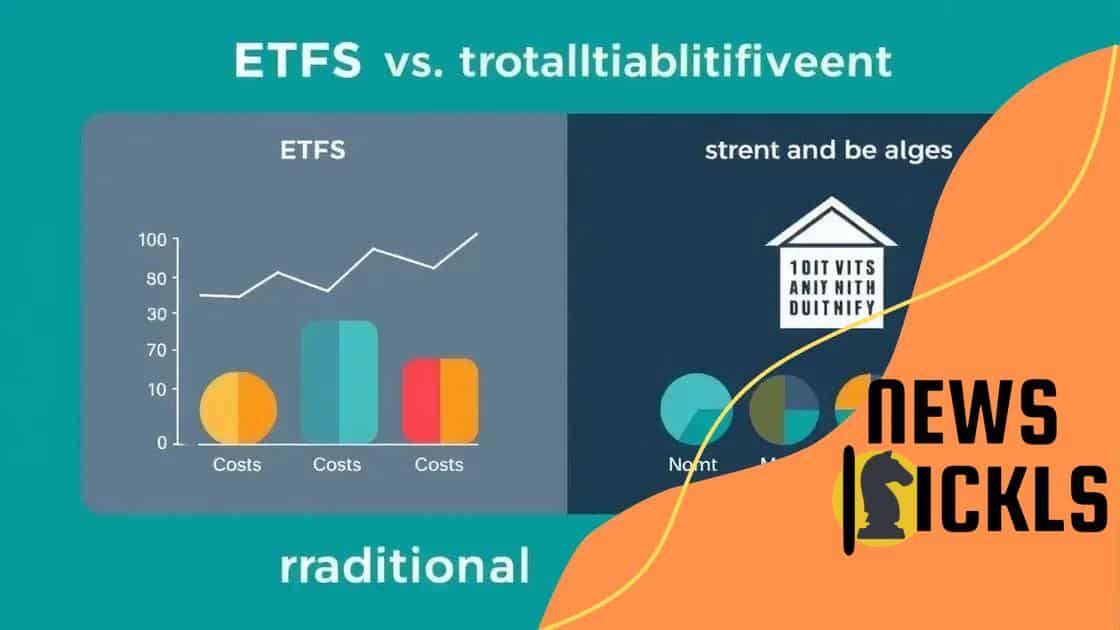The role of ETFs in diversifying investment portfolios

The role of ETFs in diversifying investment portfolios enhances risk management and provides exposure to various asset classes, making them essential components of a modern investment strategy.
The role of ETFs in diversifying investment portfolios is more critical than ever in today’s financial landscape. But have you ever considered how these financial tools can enhance your investment strategy? Let’s dive in!
Understanding ETFs and Their Functionality
Understanding ETFs is essential to enhancing your investment portfolio. Exchange-Traded Funds (ETFs) offer investors a chance to invest in a diversified range of assets while enjoying flexibility and lower costs. Unlike mutual funds, ETFs trade on stock exchanges, allowing you to buy and sell them just like individual stocks.
What are ETFs?
ETFs are investment funds that hold a collection of assets, such as stocks, bonds, or commodities. They are designed to track the performance of a specific index, sector, or commodity. This means that by investing in an ETF, you can gain exposure to a broad market segment without having to buy each individual security.
Key Features of ETFs
- Liquidity: ETFs can be traded throughout the day on stock exchanges, providing you with the flexibility to buy and sell whenever the market is open.
- Cost Efficiency: Generally, ETFs have lower expense ratios compared to mutual funds, making them a budget-friendly option for many investors.
- Diversification: Investing in an ETF allows you to own multiple assets, spreading your risk across different sectors or markets.
- Transparency: Most ETFs regularly disclose their holdings, so you can see exactly what assets you own.
Another appealing aspect of ETFs is their tax efficiency. Since ETFs are structured in a unique way, they often generate fewer taxable events compared to mutual funds. This can lead to potential tax savings over time. Furthermore, ETFs can be used for various investment strategies, including hedging and tactical asset allocation.
Investors also appreciate the flexibility to purchase shares on margin or sell short, which adds to their appeal as a versatile investment vehicle. With the rise of technology, many investors can now easily buy and manage ETFs through online brokerage platforms, making them accessible to a wider audience.
In summary, understanding the functionality and benefits of ETFs is crucial as you consider diversifying your investment portfolio. By learning how they work, you can make informed decisions that align with your financial goals.
Ways ETFs Improve Portfolio Diversification
Ways ETFs improve portfolio diversification can greatly impact your investment success. By incorporating ETFs into your strategy, you can reduce risk and enhance potential returns. Let’s explore how this is achieved.
Variety of Asset Classes
ETFs allow investors to access a wide range of asset classes. You can invest in stocks, bonds, real estate, or commodities, all within a single fund. This variety is key to minimizing risk. For instance, if one sector underperforms, others may perform well, balancing your overall portfolio.
Low Correlation Benefits
Investing in ETFs that cover different markets or sectors can provide low correlation among assets. This means that even if some assets move in different directions, your portfolio as a whole remains stable. By diversifying across various sectors, you reduce the impact of market volatility.
- Risk Reduction: Having assets in different categories lowers overall risk.
- Increased Stability: When one sector dips, others may rise, keeping your overall investment secure.
- Global Exposure: International ETFs give you access to foreign markets, further diversifying your risk.
Another way ETFs help is through their structure, which often tracks indices. Index ETFs hold a variety of stocks within an index, providing instant diversification and protecting you against poor performance from individual stocks. This is a great advantage for passive investors who prefer a hands-off approach.
By carefully selecting ETFs that align with your investment goals, you can strategically diversify your portfolio. Whether through sector rotation or thematic investing, ETFs provide valuable tools to adjust your investment strategy based on market conditions.
Incorporating ETFs into your investment plan not only enhances diversification but can also achieve a more balanced risk-return profile, making your investment journey smoother.
Comparing ETFs to Traditional Investments

Comparing ETFs to traditional investments reveals critical differences that can shape your investment strategy. While both serve the purpose of growing wealth, they operate in distinct ways. Understanding these differences can help you choose the right option.
Liquidity and Trading
One major difference is liquidity. ETFs trade on exchanges like stocks, allowing you to buy and sell them throughout the day. This means you can react quickly to market changes. In contrast, traditional mutual funds only trade at the end of the day, limiting your ability to execute timely trades.
Cost Structure
Another key factor is cost. ETFs generally have lower expense ratios than traditional mutual funds. This is mainly due to their passive management approach, which typically incurs lower fees. Additionally, you avoid sales loads often associated with mutual funds, meaning your investment starts working for you faster.
- Trading Costs: While ETFs may have lower management fees, consider the trading costs and commissions that might apply.
- Tax Efficiency: ETFs are often more tax-efficient compared to mutual funds, thanks to their unique structure that generates fewer capital gains.
- Investment Minimums: Many mutual funds require a minimum investment, while ETFs can be purchased with as little as one share.
Moreover, ETFs provide greater transparency. With ETFs, you can easily see the underlying assets in real-time. In contrast, mutual funds may only disclose holdings monthly or quarterly. This transparency can help you make more informed decisions about your investments.
Both ETFs and traditional investments have their strengths. Factors like your investment goals, risk tolerance, and preferred management style will guide your choice. For instance, if you prefer a hands-on approach, traditional mutual funds may align better with your style. However, if you want more control and flexibility, ETFs could be the better option.
Risks and Considerations When Investing in ETFs
Risks and considerations when investing in ETFs are essential to understand before diving into this investment avenue. While ETFs offer many benefits, they also come with certain risks that can affect your overall investment performance. It’s crucial to approach them with a clear understanding of these factors.
Market Risk
Just like any other investment, ETFs are subject to market risk. This means that the value of your ETF investment can fluctuate based on market conditions. If the overall stock market declines, the value of your ETFs could also drop, affecting your returns. Staying informed about market trends can help you make better investment decisions.
Liquidity Considerations
While most ETFs are liquid, some specialized or niche ETFs may have lower trading volumes. This can result in wider bid-ask spreads, making it more costly to enter or exit your position. Always check the trading volume and liquidity before investing to ensure that you can buy or sell without significant delays or costs.
- Expense Ratios: Though typically lower than mutual funds, high expense ratios can eat into your profits over time.
- Tracking Error: Some ETFs may not perfectly replicate the performance of their underlying index, leading to discrepancies in expected returns.
- Concentration Risk: Investing in ETFs that focus on specific sectors can expose you to risks tied to those particular industries.
Understanding the tax implications of ETFs is also vital. Although ETFs are generally tax-efficient, capital gains distributions can occur, impacting your overall tax liabilities. It’s important to be aware of how your ETF investments may affect your tax situation and consult with a tax advisor if needed.
Investing in ETFs can be an effective way to diversify your portfolio. However, it is essential to be mindful of the risks involved. By researching and analyzing these considerations, you can make informed decisions that align with your financial goals. Always evaluate your risk tolerance before making any investment choices.
How to Choose the Right ETFs for Your Portfolio
Choosing the right ETFs for your portfolio requires careful consideration of your investment goals, risk tolerance, and market conditions. By understanding these factors, you can make informed decisions that support your financial objectives.
Define Your Investment Goals
Start by clarifying your investment goals. Are you looking for long-term growth, income generation, or a mix of both? This will help you determine which types of ETFs align with your objectives, from equity ETFs to bond ETFs, or even sector-specific options.
Assess Your Risk Tolerance
Your risk tolerance is a crucial element in choosing the right ETFs. Assess how comfortable you are with market fluctuations. If you have a high-risk tolerance, you might opt for sector or thematic ETFs, which can be more volatile. Conversely, if you prefer stability, consider more diversified and established ETFs.
- Look at Historical Performance: Review the historical performance of potential ETFs. Past performance can offer insights, but remember it does not guarantee future results.
- Expense Ratios: Compare expense ratios among ETFs. Lower costs can lead to better overall returns over time, so seek options with competitive fees.
- Fund Size and Liquidity: Choose ETFs that are well-established and possess enough liquidity. This ensures that you can buy and sell shares easily without large price changes.
Another important factor is the underlying index or assets the ETF tracks. Understanding what the ETF comprises will help you evaluate whether it fits within your current portfolio. For example, diversifying into international markets may enhance your exposure to different economies.
Additionally, keep an eye on macroeconomic trends that might influence specific sectors or regions. An ETF that focuses on technology may perform differently based on tech industry trends, while a bond ETF may react differently to interest rate changes.
Finally, remember that maintaining a diversified portfolio is essential. Balancing different types of ETFs can mitigate risk and enhance return potential, leading to a more robust investment strategy over time.
FAQ – Frequently Asked Questions about ETFs and Investment Portfolio
What are ETFs and how do they work?
ETFs, or Exchange-Traded Funds, are investment funds that are traded on stock exchanges. They hold a collection of assets, like stocks or bonds, and can be bought and sold throughout the trading day like individual stocks.
How can I choose the right ETFs for my investment goals?
To choose the right ETFs, define your investment goals, assess your risk tolerance, and compare expense ratios. Selecting ETFs that align with your objectives is essential for your financial strategy.
What risks are associated with investing in ETFs?
Investing in ETFs involves risks such as market risk, liquidity issues, and tracking errors. Understanding these risks will help you make informed decisions when including ETFs in your portfolio.
How do ETFs differ from traditional mutual funds?
ETFs trade on exchanges like stocks and can be bought and sold throughout the day, whereas mutual funds only trade at the end of the trading day. ETFs usually have lower expense ratios and greater tax efficiency.






